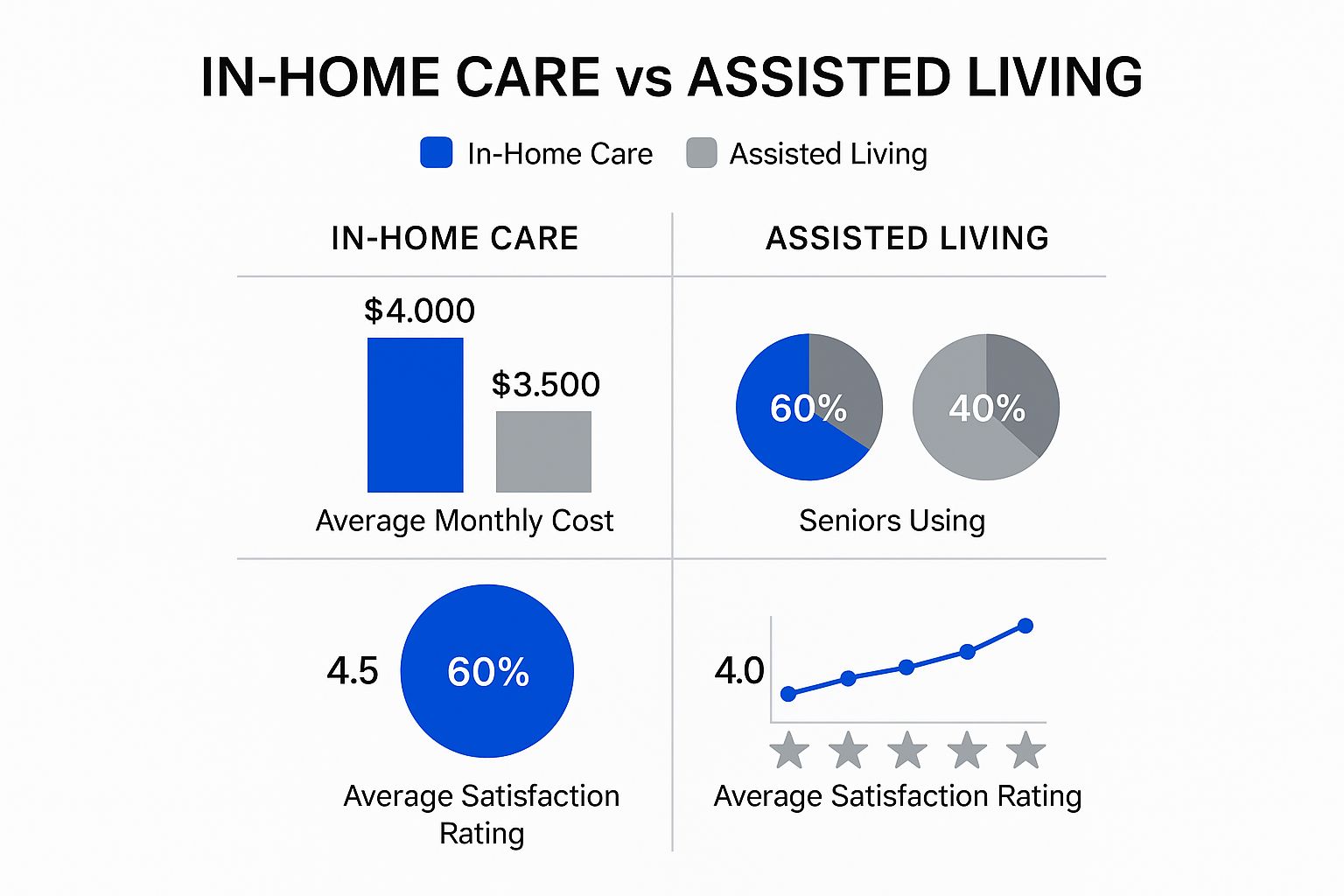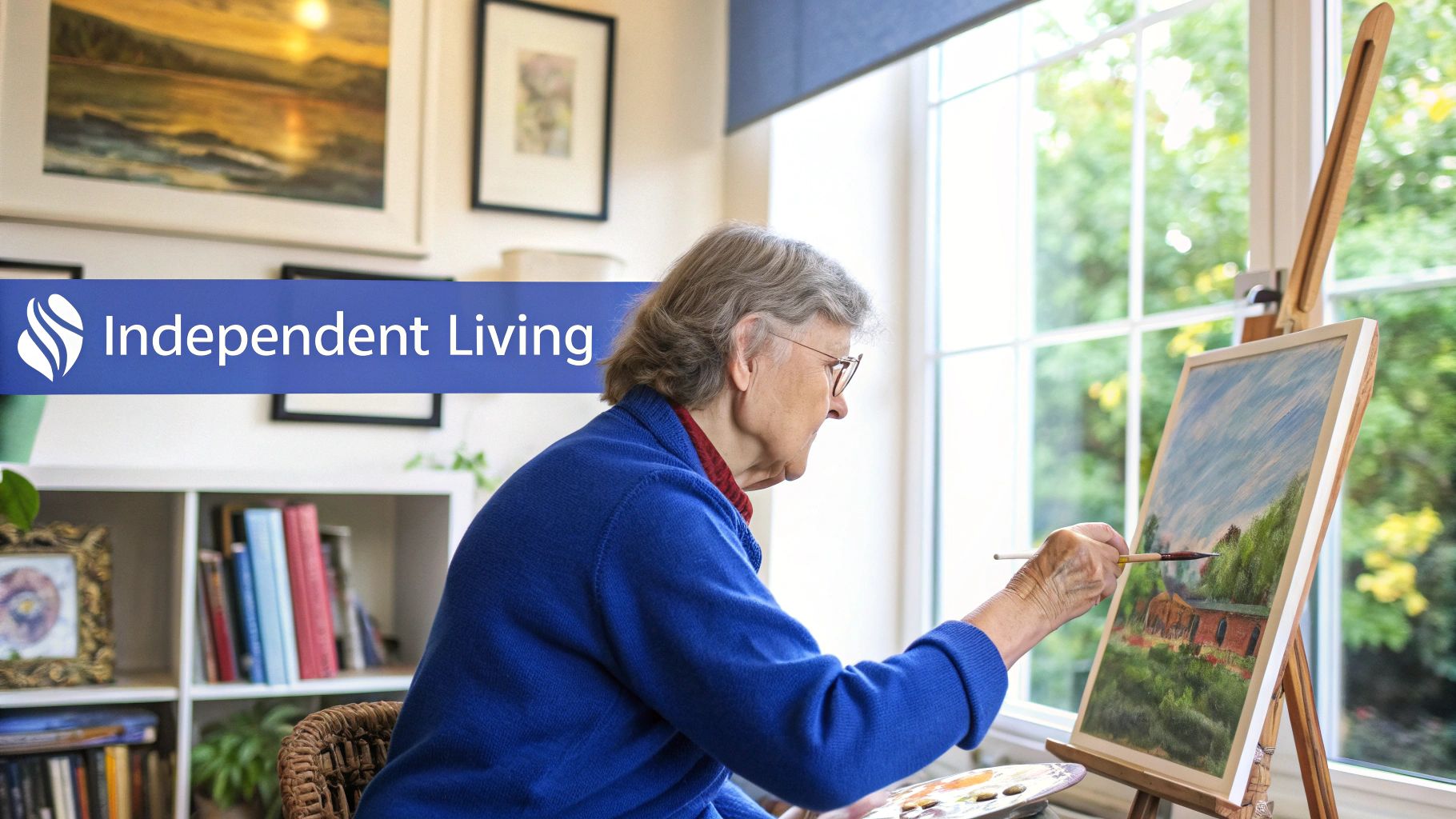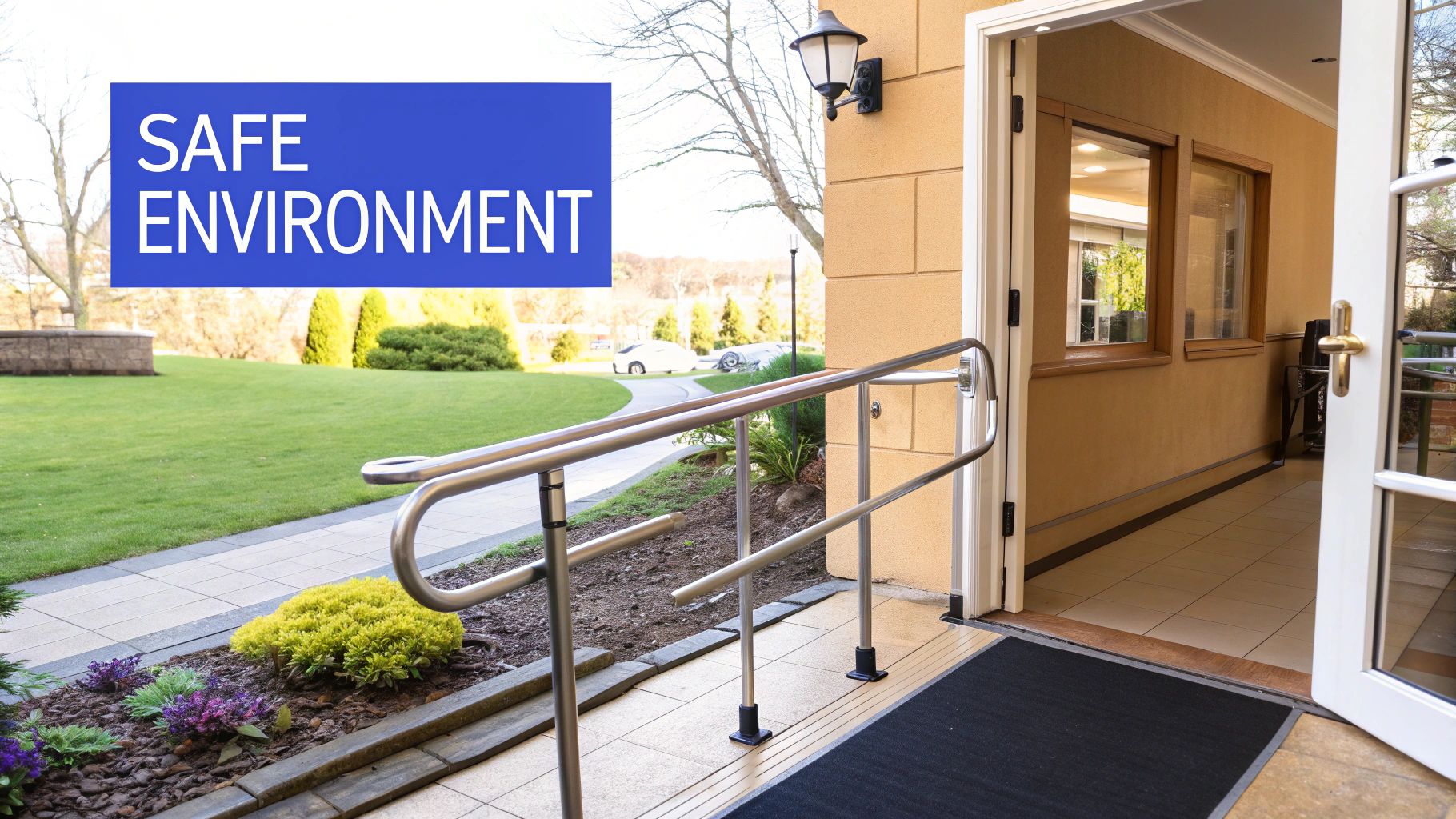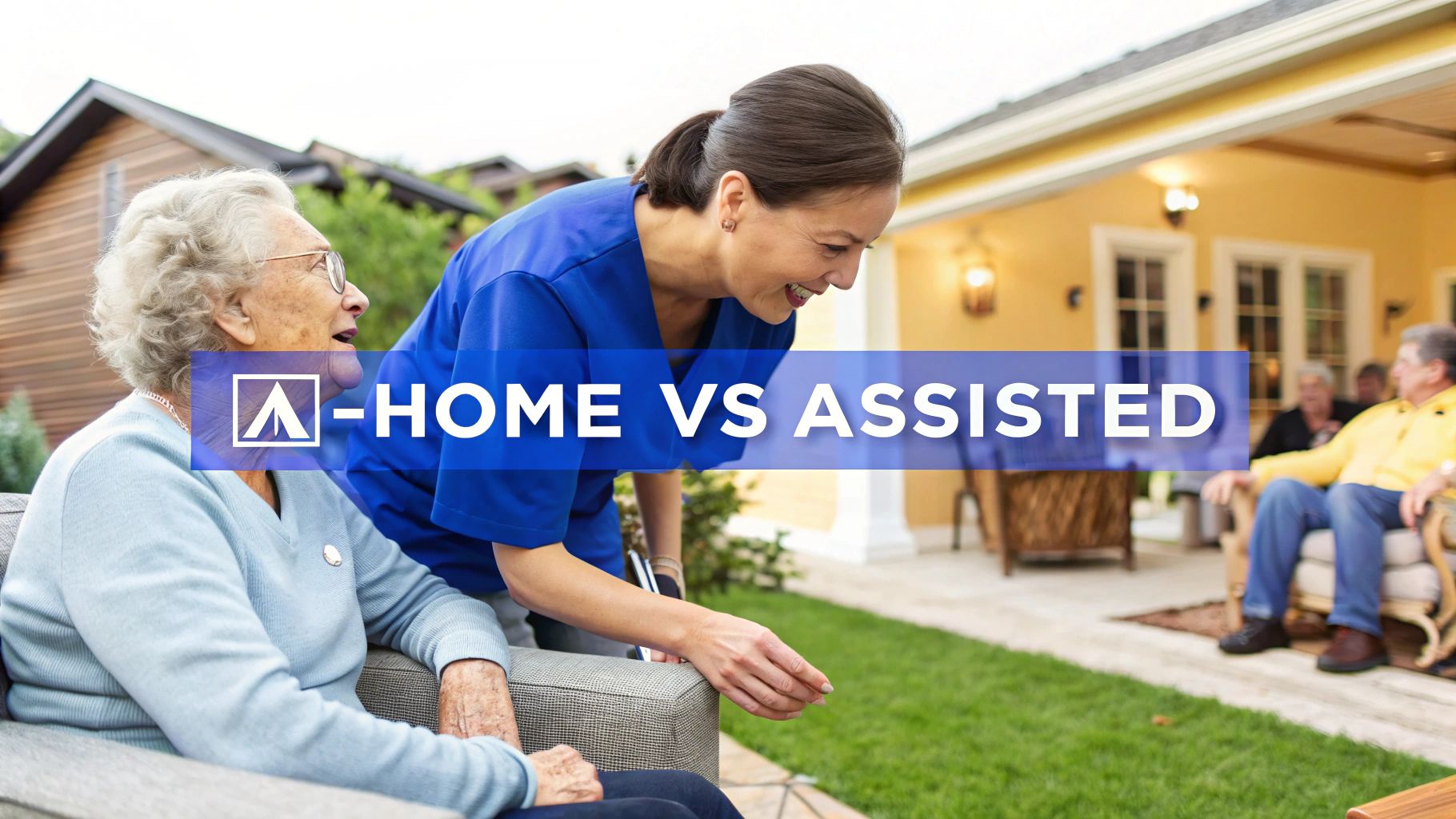When you're starting to explore senior care, the first major fork in the road is often the in-home care vs. assisted living decision. It boils down to a fundamental choice about lifestyle and location. In-home care brings personalized, one-on-one support right into the familiar comfort of your own home. On the other hand, assisted living offers care within a structured community, bundling housing, meals, and social life into one package.
The right path really depends on what you value most: the independence of staying put or the built-in community and comprehensive services of a facility.
Choosing Your Path In Senior Care
Making this decision well goes far beyond a simple cost comparison. It’s a choice that pits the deep comfort and autonomy of a familiar environment against the social buzz and bundled convenience of community living. While many families get stuck on the numbers at first, the best choice always balances finances with lifestyle preferences, social needs, and the specific level of care a person truly requires.
This is a decision packed with emotion and practical considerations. The data often reflects this.

As you can see, even though in-home care might have a higher average price tag, it consistently scores higher in satisfaction. It's also the preferred option for the vast majority of seniors, which speaks volumes about the powerful desire to age in place.
The Appeal of Aging in Place
That desire to stay home is a massive factor in the in-home care vs. assisted living debate. The trend is undeniable and overwhelming. An estimated 90% of seniors in the United States say they want to remain in their own homes for as long as possible, rather than move into any kind of institutional setting. This preference is so strong that it's actively reshaping the entire senior care industry. If you want to dig deeper, you can explore more home care industry statistics to understand this shift.
The core decision isn't just about where care happens, but how it's delivered. In-home care is a highly personalized service built around an individual's existing life, while assisted living asks an individual to adapt to a new community-based lifestyle.
In-Home Care vs Assisted Living At a Glance
To really get a feel for the two models, it helps to see them side-by-side. Each offers a completely different approach to daily life, social connection, and how care is managed. Getting these fundamentals straight is the perfect first step before you dive into the nitty-gritty financial and personal details that will ultimately guide your family's choice.
Here’s a quick breakdown of the core differences:
| Aspect | In-Home Care | Assisted Living |
|---|---|---|
| Living Environment | Stays in their own private home, surrounded by their own things. | A private or semi-private apartment within a larger, managed facility. |
| Social Dynamics | One-on-one companionship with a caregiver; relies on existing friends and family. | A built-in community with peers, scheduled activities, and group dining. |
| Cost Structure | Usually billed at an hourly rate; total cost depends on how many hours of care are needed. | An all-inclusive monthly fee that covers rent, meals, utilities, and basic care services. |
| Care Level | Highly customized and flexible, from simple companion care to skilled nursing tasks. | More standardized assistance with daily activities, medication reminders, and 24/7 staff on-call for safety. |
This table gives you the "10,000-foot view," but remember that the best option is always the one that best fits the individual's unique health needs, personality, and budget.
A Realistic Look at Senior Care Costs

When you start comparing in home care vs assisted living, the cost is usually the biggest, and frankly, most confusing piece of the puzzle. It's easy to get sticker shock from advertised rates, but those numbers almost never tell the whole story. To make a smart decision, you have to dig deeper than the initial price tag and uncover all the expenses—both the obvious and the hidden.
Assisted living looks simple enough on the surface with its bundled monthly fee. In-home care, on the other hand, can feel like you’re piecing together a quilt, with hourly rates and à la carte services. Let's break down what you're really paying for with each option so you can spot the financial tipping point for your own family.
Decoding the Cost of Assisted Living
Assisted living communities generally run on a rental model, which gives you a predictable, all-in-one price. That monthly fee typically bundles a core set of services, making it much easier to budget from month to month.
So, what does that base rate usually cover?
- Housing: A private or semi-private apartment, with utilities included.
- Meals: Three meals a day in a community dining room, plus snacks.
- Basic Care: General help with activities of daily living (ADLs) and reminders for medication.
- Amenities: Access to social events, common spaces, and scheduled transportation.
But be careful with the term "all-inclusive." It can be a bit misleading. Many essential services will cost extra and can quickly inflate that monthly bill. These add-ons often involve higher levels of personal care, specialized memory support for dementia, incontinence supplies, or even just having someone escort your loved one to a doctor's appointment. Always ask for a detailed list of what's included versus what costs more.
Unpacking the Variable Costs of In-Home Care
The cost of in-home care is all over the map because it’s built around one person’s specific needs. The caregiver's hourly rate is the main expense, but it's just one part of a much bigger financial equation.
While you aren’t paying a facility fee, you’re still responsible for every single cost of keeping up the house. These are the expenses families consistently underestimate when they're trying to compare their options head-to-head.
The biggest budgeting mistake I see families make with in-home care is completely forgetting about homeownership costs. Property taxes, insurance, repairs, and utilities don’t just vanish. You have to add them to the caregiver's wages to get a true picture of the total expense.
For a realistic budget, you must factor in:
- Caregiver Wages: This is your largest line item, based on how many hours and what level of care is needed.
- Home Maintenance: Ongoing costs for repairs, yard work, and those lovely surprises like a broken water heater.
- Utilities: Your electricity, water, and heating bills will likely go up with someone in the house 24/7.
- Home Modifications: Installing grab bars, a wheelchair ramp, or a stairlift can be a major one-time investment to ensure safety.
When you put all the numbers side-by-side, the financial reality becomes much clearer. Recent data shows the average cost for a private room in an assisted living facility was about $5,511 per month in 2024. In contrast, full-time, round-the-clock in-home care services hit around $6,481 monthly. Tack on necessary expenses like home maintenance—which can average $3,725 per month—and the cost of aging at home can easily blow past what you'd pay for an assisted living community. You can learn more about these 2025 senior care cost comparisons to see a complete breakdown.
This all points to a critical financial tipping point. If a senior only needs a few hours of help each week, in-home care is almost always the more affordable route. But once care needs ramp up to 40 or more hours per week, the predictable, bundled costs of assisted living often become the more sensible and sustainable financial choice.
Comparing Daily Life and Social Connections

The choice between in home care vs assisted living goes far beyond just medical support or daily help. It’s a decision that fundamentally changes a person’s daily rhythm, their social life, and their overall sense of purpose. How a loved one spends their days and who they spend them with will look completely different in each scenario. To make the right choice, you have to look past the logistics and understand which environment will help them not just live, but truly thrive.
One path prioritizes the comfort of routine in a cherished home, while the other offers the energy of a new, built-in community. Neither is automatically better, but one is almost certainly a better fit for your loved one’s personality and social needs.
The Rhythm of Life with In-Home Care
For many older adults, the biggest draw of in-home care is simple: they get to stay put. Waking up in your own bed, brewing coffee in a familiar kitchen, and looking out at the same backyard you’ve known for years provides a powerful sense of comfort and independence.
A day with in-home care is built around the senior’s existing life. A caregiver might arrive in the morning to help with bathing and breakfast, then provide a ride to a doctor’s appointment or join them for a walk. The day still belongs to the senior; the care is there to support it, not define it.
This setup naturally leads to a close, one-on-one bond between the senior and their caregiver. That relationship often becomes a central source of companionship, offering consistent and personal interaction.
The most significant risk of in-home care is not a lack of care, but a lack of connection. If a senior's social circle has diminished, relying solely on a caregiver and occasional family visits can lead to profound loneliness and isolation.
To make in-home care successful, families need to be intentional about creating social opportunities. This can look like:
- Arranging rides to the local senior center or community gatherings.
- Scheduling consistent visits from friends, neighbors, and other family members.
- Helping them stay involved in clubs, church groups, or volunteer work.
Without that dedicated effort, the quiet comfort of home can quickly become isolating. The success of in-home care often hinges on the strength of the senior's existing social web and the family’s commitment to keeping it active.
The Community and Structure of Assisted Living
Assisted living, on the other hand, is built from the ground up to be a social environment. The day-to-day is more structured, with opportunities for interaction woven into the fabric of the community. While moving is a big adjustment, it can replace the risk of isolation with an instant group of peers.
Life in assisted living is anchored by shared experiences. Meals are usually served in a communal dining hall, turning breakfast, lunch, and dinner into social occasions instead of solitary tasks. This simple change is one of the most powerful tools for fighting loneliness.
Beyond meals, these facilities offer a packed calendar of curated activities, designed for different interests and mobility levels. This removes the entire burden of planning and transportation that often keeps seniors at home.
A Sample Assisted Living Activity Calendar Might Include:
- Morning fitness classes like chair yoga or tai chi.
- Afternoon card games, book clubs, or art workshops.
- Evening movie nights, live music performances, or social hours.
This built-in structure provides a stimulating and predictable rhythm. For an outgoing senior, or for someone who has become lonely and withdrawn at home, the steady hum of activity and easy access to friends can be a breath of fresh air. Ultimately, the in home care vs assisted living debate often comes down to this: does your loved one draw energy from quiet independence or from a lively, structured social life? The best choice is the one that matches their personality.
When you’re weighing in home care vs assisted living, one of the biggest differences comes down to how care is delivered and adjusted. It’s not just about a list of services. It’s about who provides the care, how personalized it is, and how it adapts when health needs change.
Essentially, one model is built from the ground up for one-on-one, flexible support, while the other offers standardized, team-based care within a larger community.
The Personalized Spectrum of In-Home Care
In-home care is hands-down the most customizable care model out there. Services can be dialed up or down with incredible precision, letting you build a plan that fits a senior’s exact needs today and easily evolves tomorrow. That flexibility is its greatest strength.
At its most basic, in-home care can start with companionship and help with those instrumental tasks of daily living (IADLs), like:
- Running errands and picking up groceries
- Light housekeeping, laundry, and keeping the home tidy
- Planning and preparing nutritious meals
- Providing rides to doctor’s appointments or social outings
As personal care needs grow, the service can expand to include hands-on assistance with Activities of Daily Living (ADLs)—the fundamental tasks of self-care. This means direct help with things like bathing, getting dressed, personal grooming, and moving safely around the house.
The real game-changer for in-home care is its ability to bring skilled medical services right into the home. This blurs the line between simple assistance and clinical-level support, creating a seamless continuum of care that most facilities just can't replicate.
For someone with more complex health problems, in-home care can dispatch licensed clinicians to their door. This skilled nursing care, provided by Registered Nurses (RNs) or Licensed Practical Nurses (LPNs), covers services like wound care, IV therapy, injections, and managing complicated medication schedules. This level of medical support is what allows many seniors with chronic conditions to stay in their own homes safely and comfortably.
The Standardized Support of Assisted Living
Assisted living communities are built to provide a solid foundation of support for residents who are still largely independent but need a little help here and there. The entire model is designed for safety, convenience, and community-wide efficiency.
The standard care package usually centers on ADL assistance, delivered by a team of trained aides. This means residents can get help with bathing, dressing, and other personal tasks whenever they need it. A core feature is medication management, where staff ensures residents take the correct medications at the right time—a simple service that significantly reduces a common risk for seniors.
Another key benefit is the 24/7 staff availability. While residents aren't getting constant one-on-one attention, there's tremendous peace of mind in knowing someone is always on-site and ready to respond if there’s an emergency, like a sudden fall.
But it's important to know that assisted living has its limits. It is not a medical facility. While you’ll often find a registered nurse on-site or on-call to oversee care plans and handle minor issues, these communities aren't set up to manage complex, acute, or unstable medical conditions. If a resident's needs become too great—like requiring daily wound care or extensive help with mobility—a move to a skilled nursing facility (a nursing home) is the next step.
Comparing Available Care Services
To get a clearer picture in the in home care vs assisted living debate, it’s helpful to see a direct comparison of the services available in each setting. The table below breaks down how each environment typically handles common care needs.
Comparing Available Care Services
| Service Category | In-Home Care Availability | Assisted Living Availability |
|---|---|---|
| ADL Assistance | Fully Customized: Provided one-on-one, scheduled precisely when needed. | Team-Based: Available as needed from a team of aides serving all residents. |
| Medication Management | Customized: Can range from simple reminders to complex administration by a nurse. | Standardized: Typically involves reminders or dispensing from a central station. |
| Skilled Nursing | Available: Licensed nurses can provide a wide range of medical services at home. | Limited/Unavailable: Not equipped for clinical care; requires a move to a higher-level facility. |
| 24/7 Emergency Help | Conditional: Available only with a live-in caregiver or via a medical alert system. | Standard: Staff is on-site 24/7 to respond to emergencies for all residents. |
Ultimately, the right choice really hinges on the type of care required. If your loved one's needs are fairly stable and mostly non-medical, assisted living offers a reliable and social support system. But if their care needs are complex, likely to change, or require true clinical expertise, the deeply personalized and scalable model of in-home care is almost always the better fit.
Finding the Right Fit for Your Situation

The debate over in home care vs assisted living isn't about which one is better—it's about which one is the right fit for a specific person. The best choice is the one that aligns with your loved one's personality, health needs, social life, and current living situation. It’s a decision that goes beyond just services and costs; it's about understanding the kind of life they want to lead.
One path focuses on independence and familiarity, while the other provides community and structured support. Once you understand who thrives in each environment, you can move forward with confidence.
The Ideal Candidate for In-Home Care
In-home care is a fantastic solution for seniors who cherish their independence and the comfort of their own home above all else. The best person for this model is often someone whose identity is deeply connected to their personal space, their neighborhood, and their daily routines.
These are often people with a strong desire to stay put, surrounded by familiar faces and a lifetime of memories.
In-home care generally works best for a senior who:
- Values Independence Above All: They want to keep control over their schedule, decide what's for dinner, and live life on their own terms.
- Lives in a Safe, Accessible Home: Their house is either already safe or can be easily modified with grab bars, ramps, or other safety features.
- Has Predictable Care Needs: Their need for support is fairly consistent, which works well with scheduled caregiver visits rather than requiring round-the-clock supervision.
- Has a Strong Support System: They have family, friends, and neighbors who are involved, providing social connection and stepping in when needed.
For this person, the one-on-one bond with a dedicated caregiver is a huge benefit. It provides consistent, personalized companionship that feels more like a partnership than just a service. The goal isn't to change their life but to support the one they've already built.
The Perfect Profile for Assisted Living
On the other hand, assisted living is an excellent choice for seniors who might be feeling isolated at home or who get a real boost from being in a social setting. It’s designed for those who would benefit from a built-in community and would be relieved to let go of the chores of homeownership.
This environment is purpose-built to combat loneliness and offer a maintenance-free lifestyle where making friends is easy.
For many families, the tipping point is when care needs become too complex or unpredictable for them to handle alone. Assisted living provides a crucial safety net with its 24/7 staff and a team-based approach to care.
Assisted living is often a great fit for a senior who:
- Thrives in a Social Environment: They enjoy group activities, sharing meals with others, and the simple companionship of living among peers.
- Is Experiencing Loneliness at Home: Their social circle may have gotten smaller, and they'd feel better in a vibrant, active community.
- Has Unpredictable or Increasing Care Needs: The family is worried about safety, and the senior needs access to support around the clock, just in case.
- Wants a Worry-Free Lifestyle: They are more than ready to hand over the responsibilities of cooking, cleaning, and home maintenance.
These profiles are backed by data. National research shows clear differences between the populations in each setting. For instance, 53% of assisted living residents are over 85 years old, and 31% have a dementia diagnosis, which points to the higher level of need in that group. Meanwhile, 86% of home care recipients are 65 or older, a group that often prefers to age in place. You can discover more home health statistics and insights that explore these trends.
Addressing Cognitive Challenges and Dementia
When dementia or cognitive decline enters the picture, the in home care vs assisted living choice becomes even more critical.
For someone in the early stages of dementia, in-home care can be perfect. The familiar surroundings of home can help reduce confusion and anxiety. A consistent, one-on-one caregiver provides a comforting routine and specialized attention that's hard to replicate elsewhere.
However, as dementia progresses, the structured safety of an assisted living facility often becomes the more practical choice. Many communities have specialized memory care units designed for residents with Alzheimer’s and other forms of dementia. These units offer secure environments to prevent wandering, specialized activities that support cognitive function, and staff who are trained to manage challenging behaviors with compassion.
Answering Your Key Questions
Even after you’ve weighed all the costs, lifestyle factors, and care levels, you’re often left with those nagging, practical questions. The real-world "what ifs" are what truly shape the in home care vs assisted living decision. Getting straight answers to these common concerns can give you the confidence to move forward.
Let’s dive into some of the most frequent questions we hear from families who are standing at this exact crossroads. Our goal is to provide clear, direct insights to help you sort through any lingering doubts.
How Do We Pay For These Options?
This is almost always the first question, and for good reason. The financial paths for in-home care and assisted living are quite different, and you need to know what to expect.
For the most part, assisted living is paid for out-of-pocket. Families typically rely on savings, retirement accounts, or money from the sale of a home. It's important to know that standard health insurance and Medicare do not cover the room and board costs associated with assisted living. Some Long-Term Care Insurance policies might offer coverage, but you’ll need to check your specific plan details to be sure.
In-home care, on the other hand, has more flexible funding avenues. While many families pay privately, there are other routes to explore:
- Long-Term Care Insurance: Most policies are designed to cover in-home care services, usually with a set daily or weekly benefit amount.
- Veterans Benefits: Programs like Aid and Attendance can offer a monthly stipend to qualifying veterans and their surviving spouses to help offset care costs.
- Medicaid: For seniors with limited income, state-run Medicaid programs often cover a large portion of in-home care through Home and Community-Based Services (HCBS) waivers.
Finding out if you qualify for programs like Medicaid or VA benefits can be a total game-changer. These programs are built specifically to help seniors age in place, making in-home care a real, affordable option for many who thought it was out of reach.
What Happens When Care Needs Change?
It’s natural to worry about the future. What if Mom needs more help than she does today, or Dad develops a medical issue that requires a higher level of care?
With in-home care, adapting is fairly simple. You can easily increase a caregiver’s hours to provide more support. If new medical needs come up, a skilled nurse can be brought in for specific tasks like managing medications or wound care. This flexibility lets the care plan grow with your loved one, all without the stress of a move.
Making a transition from assisted living is a much bigger deal. If a resident's health declines to the point where they need 24/7 medical monitoring—often called skilled nursing care—they will have to move to a skilled nursing facility, or nursing home. Even in communities that offer a "continuum of care," this still means moving to a new, more clinical setting within the campus.
What If My Parents Have Different Needs?
This is a tough, but very common, situation. What do you do when one parent is still independent while the other needs daily help? This is where the in home care vs assisted living debate really highlights its differences.
In-home care is often the perfect solution for couples with mixed needs. A caregiver can come right into the home and focus on the spouse who needs assistance, allowing the other partner to live their life with minimal disruption. It’s a solution that keeps them together in the home they love, preserving their relationship and daily routine.
Assisted living can get a little tricky for couples. While many facilities have apartments for two, you might end up paying for two different care plans, which can get pricey. Worse, if one spouse’s needs increase significantly, they may have to move to another area of the facility, like a memory care unit, effectively separating them.
Choosing the right path is a deeply personal decision. By thinking through these specific scenarios, you can better prepare for what lies ahead and select the option that brings the most comfort, stability, and peace of mind to your whole family.
At NJ Caregiving, we specialize in creating personalized in-home care plans that adapt to your family's unique and changing needs. If you believe keeping your loved one in their cherished home is the right path, we’re here to help make it happen. Learn more about our compassionate services in Princeton, NJ, by visiting us at https://njcaregiving.com.



